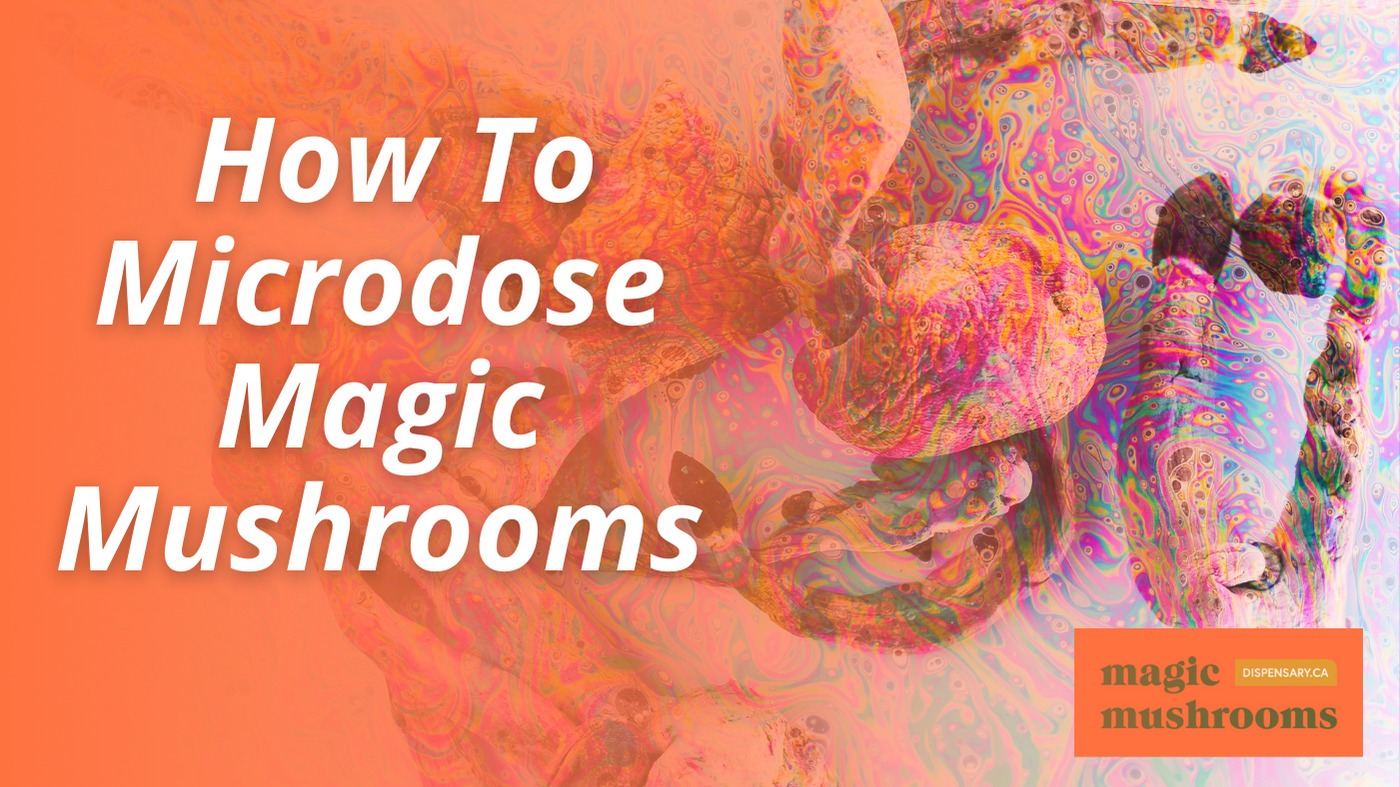Mastering the Art of How To Microdose Magic Mushrooms
The habit of microdosing psychedelic mushrooms, characterized by ingesting imperceptible quantities of psilocybin, is said to provide numerous mental and emotional advantages. Although there are plenty of anecdotal reports, the scientific field is diligently working to record and comprehend the possible effects of this practice.
However, **maneuvering** the methodology of microdosing safely and effectively remains a complex endeavor, fraught with legal uncertainties and a lack of standardized guidelines. As we explore the nuances of this practice further, it becomes evident that a more profound comprehension of its benefits and risks is essential for those considering this unconventional approach to enhancing mental well-being.
Key Takeaways
- Microdosing involves consuming 0.1g to 0.5g of magic mushrooms to enhance mental functioning.
- Psilocybin may enhance mood and focus, with potential benefits for depression and anxiety.
- Legal and sourcing considerations are crucial for safe and effective microdosing.
- Dosage, preparation, and consistent tracking are crucial to realizing the benefits of microdosing.
Understanding Microdosing
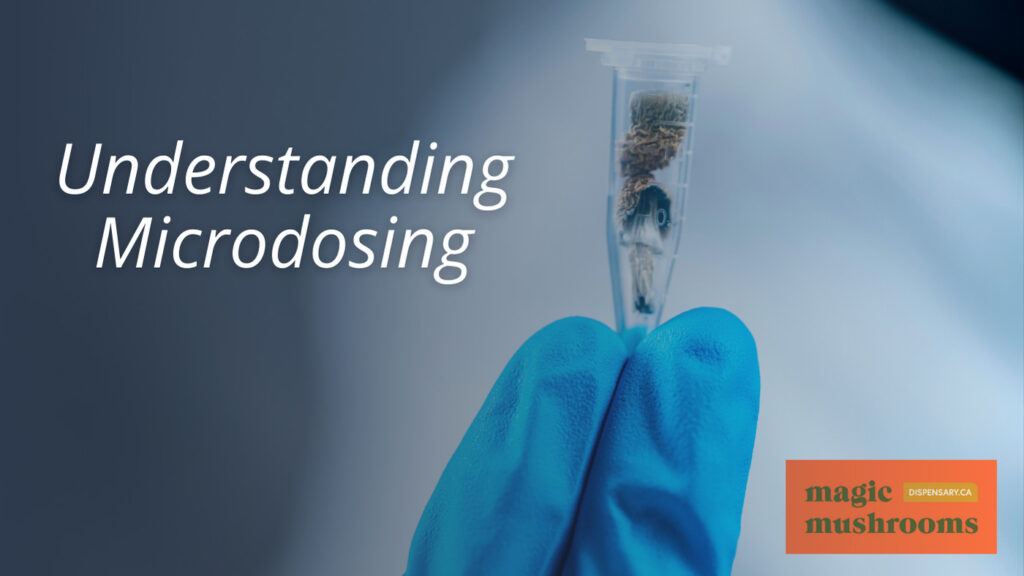
Understanding microdosing involves regularly consuming tiny, sub-perceptual doses of magic mushrooms, typically ranging from 0.1g to 0.5g, to subtly enhance mental functioning without inducing the full psychedelic effects. This practice, known as how to microdose magic mushrooms, is gaining traction among those seeking to improve their mental well-being, creativity, and focus in daily life. Microdose shroom involves:
- A disciplined and systematic approach.
- Often following a schedule developed by researchers like James Fadiman.
- Emphasizing consistency in dosing and monitoring effects.
To successfully navigate how to microdose on shrooms, individuals must pay close attention to the dosage, ensuring it remains within the sub-perceptual range to avoid the intense experiences associated with higher doses of psilocybin. Achieving the desired outcome through microdosing requires understanding one’s sensitivity and metabolism, as these factors impact how the body processes the compounds found in magic mushrooms. Additionally, the quality of mushrooms used for microdosing plays a vital role in the efficacy of this practice, highlighting the importance of sourcing from reputable suppliers.
They are learning to microdose effectively, which demands a careful balance of observation and self-awareness. Individuals must be attentive to the subtle shifts in their mental state and overall well-being, adjusting the dosage to optimize personal benefits. While anecdotal reports and some studies suggest potential advantages, such as enhanced mood and increased creativity, conclusive scientific evidence still needs to be provided. Microdosing continues to attract interest because of its potential to positively impact mental health and daily functioning.
The History of Psilocybin
Psilocybin, the psychoactive substance found in magic mushrooms, has played a significant role in the spiritual and medicinal practices of indigenous cultures since ancient times. These societies, spread across different continents, recognized the potent effects of psilocybin mushrooms and utilized them in rituals and healing ceremonies. The profound experiences elicited by psilocybin were believed to facilitate communication with the spiritual world, offering insight, healing, and enlightenment.
The modern history of psilocybin began in the mid-20th century with Swiss chemist Albert Hofmann, who first synthesized the compound in 1958. Hofmann, renowned for discovering lysergic acid diethylamide (LSD), identified psilocybin while researching the chemical constituents of the Psilocybe genus of mushrooms. This milestone in psychedelic research marked the beginning of scientific exploration into the effects and potential therapeutic applications of psilocybin.
In the 1960s, the use of psilocybin mushrooms surged in popularity, particularly within the counterculture movement. This era, characterized by widespread experimentation with psychedelic substances, brought psilocybin to the attention of the Western world. Despite the growing interest, legal restrictions soon followed, limiting research and the use of psilocybin.
However, recent years have witnessed a resurgence in scientific interest regarding psilocybin’s potential for treating various mental health disorders. Controlled clinical studies are now exploring psilocybin-assisted therapy as a means to address conditions such as depression and anxiety, paving the way for a new understanding of its therapeutic benefits. This shift reflects a broader reconsideration of psilocybin’s place in medicine and society, underscoring the importance of ongoing research.
Benefits of Microdosing
Microdosing magic mushrooms, a practice involving the consumption of sub-perceptual doses of psilocybin, has been associated with a range of potential benefits, including enhanced mood and increased focus. This burgeoning interest is underscored by anecdotal reports and preliminary studies suggesting that small, regular doses of psilocybin—the psychoactive substance found in magic mushrooms—could lead to significant improvements in day-to-day functioning without the intense hallucinogenic experiences typically associated with higher doses of psychedelics.
A notable portion of individuals who engage in microdosing report a marked improvement in their mood. According to a study, 26.6% of microdosers experienced an uplift in spirits, which aligns with subjective accounts from the microdosing community. This mood enhancement is particularly relevant in discussions about alternative treatments for mood disorders, where conventional therapies may fall short or lead to undesirable side effects.
Moreover, increased focus is another commonly cited benefit, with 14.8% of study participants acknowledging this positive change. This suggests that micro-dosing psilocybin could potentially aid in tasks that require sustained attention, thereby improving productivity and possibly even creativity. Such effects could have wide-ranging implications for both personal and professional development.
In addition, some individuals have reported a reduction in symptoms of depression and anxiety, indicating that microdosing may offer therapeutic benefits beyond those of traditional antidepressant medications. The fact that psilocybin-only users report more substantial benefits, such as improved mood, compared to users of other substances points to the unique potential of psilocybin as a microdosing compound. This emerging evidence suggests that further research into the benefits of microdosing magic mushrooms could illuminate new pathways for enhancing mental health and well-being.
Potential Risks and Side Effects
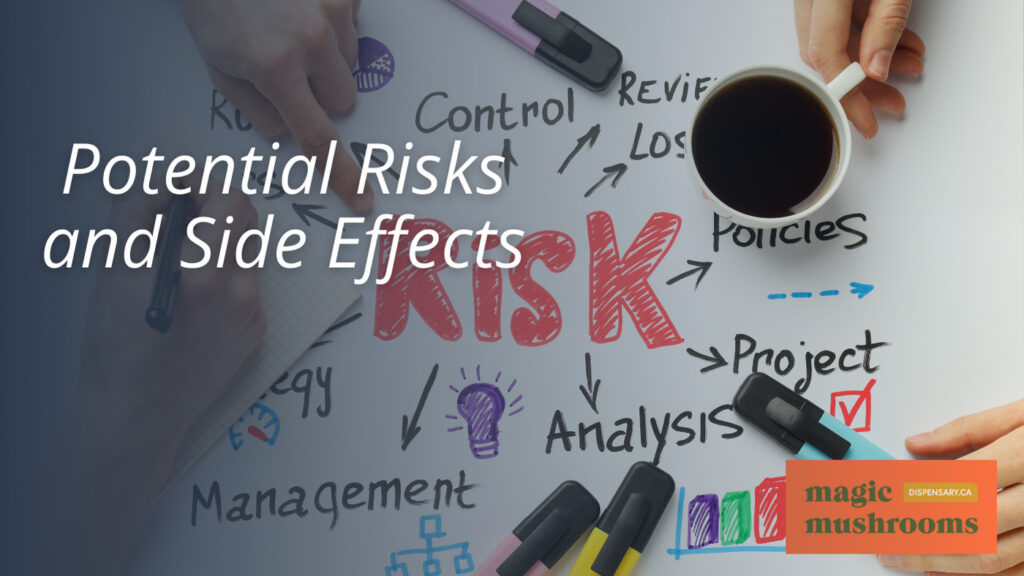
While the potential benefits of microdosing magic mushrooms have garnered attention, it is equally important to contemplate the associated risks and side effects. Engaging in this practice comes with various health concerns that should not be overlooked. For instance, individuals may experience mild physical discomforts such as nausea, headaches, or stomach upset following ingestion. Though generally considered mild, these side effects can vary widely among users and may detract from the perceived benefits of microdosing.
Additionally, psychological effects, including increased anxiety, restlessness, or difficulty sleeping, have been reported. These side effects underscore the importance of approaching microdosing with caution, particularly for those with pre-existing mental health conditions. The potential for exacerbating symptoms of anxiety or triggering psychosis in susceptible individuals cannot be ignored.
The long-term effects of microdosing magic mushrooms remain primarily unexplored, adding a layer of uncertainty to its safety profile. This gap in knowledge raises concerns about possible unknown risks to mental health that could emerge with prolonged use. Also, the risk of developing tolerance with repeated use is a pertinent issue. Overuse or incorrect dosing can diminish the desired effects and may lead to adverse outcomes, stressing the need to manage dosing schedules carefully.
Given these risks, individuals considering microdosing should proceed with caution and be mindful of their mental health history. While intriguing for its potential benefits, the practice is not without its challenges and pitfalls.
Legal Considerations
Exploring the legal landscape is essential for individuals considering microdosing with magic mushrooms, given its illegal status in many jurisdictions. Despite the growing interest and anecdotal reports of benefits, the possession and use of psilocybin-containing mushrooms remain a criminal offense in several countries, including Canada. The controlled status of psilocybin, the psychoactive compound in these fungi, means that even small, microdose-level amounts can lead to legal consequences. This includes potential fines, criminal charges, and even incarceration.
Law enforcement agencies do not differentiate between microdosing for personal well-being and larger doses intended for recreational use. Consequently, individuals caught with magic mushrooms are subject to the full extent of the law, regardless of the quantity or intended use. This legal rigidity underscores the importance of being thoroughly informed and cautious about the legal ramifications of microdosing with magic mushrooms.
Additionally, the legal landscape surrounding psychedelics is in a state of flux in various regions around the world. Some jurisdictions are beginning to explore the therapeutic potential of psychedelics, leading to changes in legislation that could eventually decriminalize or legalize their use under specific conditions. However, these developments are uneven, and the current legal framework in most places remains prohibitive.
Given these complexities, individuals interested in microdosing with magic mushrooms must navigate a challenging legal environment. It is essential to stay updated on the evolving laws and regulations in one’s specific locale to avoid unintended legal complications. The dynamic nature of psychedelic legislation demands vigilance and a proactive approach to understanding one’s legal obligations and rights.
Sourcing Quality Mushrooms
Given the previously discussed legal considerations, it is essential to focus on sourcing quality magic mushrooms safely and responsibly. Acquiring mushrooms that are both effective for microdosing and safe for consumption requires careful attention to their source and condition. High-quality magic mushrooms can typically be sourced from reputable suppliers or trusted growers focusing on organic, contaminant-free cultivation practices. Ensuring that the mushrooms are free from pesticides and other harmful chemicals and properly dried is essential for safe microdosing.
Online platforms, including specialized websites and forums, have emerged as valuable resources for individuals looking to purchase quality magic mushrooms. These platforms often feature reviews and feedback from other users, which can be helpful in determining a supplier’s reliability and quality. However, it is critical to conduct thorough research and exercise due diligence when exploring online sources to avoid potential legal issues and guarantee the purity and potency of the mushrooms.
In regions where psilocybin is legalized or decriminalized, local dispensaries or shops may offer a more straightforward option for sourcing quality mushrooms. These establishments are typically regulated and may provide lab-tested products, ensuring that consumers can access safe and effective microdosing mushrooms.
Regardless of the source, it is imperative to prioritize safety and responsibility. Proper research and verification of the supplier’s credibility and the product’s quality are fundamental steps in ensuring a positive and beneficial microdosing experience with magic mushrooms.
Dosage Guidelines
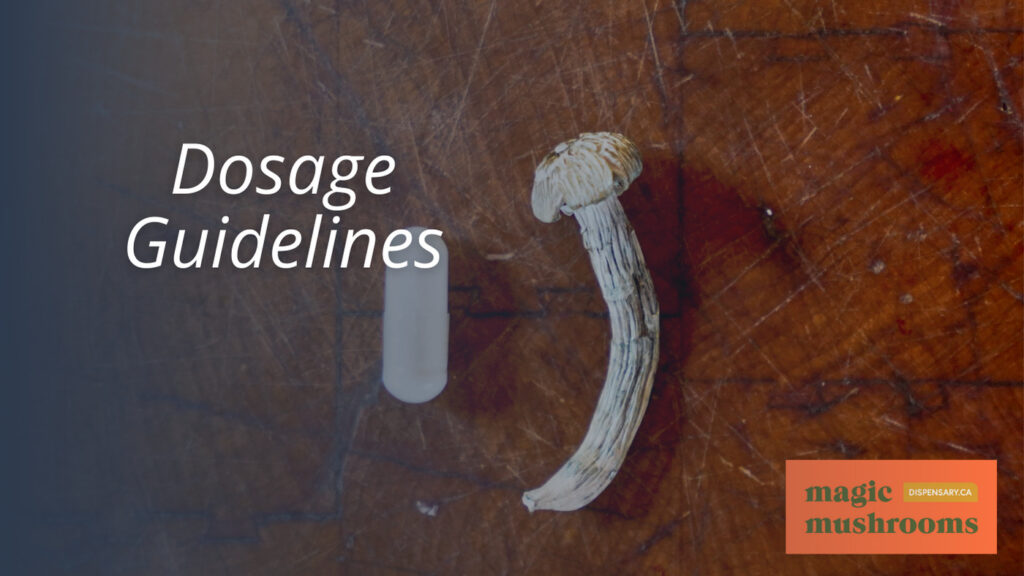
Determining the correct dosage of magic mushrooms for microdosing requires careful consideration of several critical factors, including body weight, metabolism, and individual tolerance levels. Microdosing aims to achieve subtle, beneficial effects on mental health and daily functioning without experiencing the intense psychoactive experiences associated with higher doses. A typical dosage for microdosing ranges from 0.1g to 0.5g. Starting at the lower end of this spectrum and gradually adjusting is recommended to find the best dose that meets individual needs and preferences.
Using a precise scale to measure the amount of magic mushrooms is essential for accurate dosing and consistency. This ensures that each microdose is as close to the desired amount as possible, minimizing the risk of unintended effects. The variability in individual responses to psilocybin, the active compound in magic mushrooms, underscores the importance of starting with a low dose. Factors such as body weight, metabolism, and tolerance can significantly influence how one responds to a given amount of psilocybin.
Adhering to a structured dosing schedule, like the one proposed by James Fadiman, can help individuals maintain consistency in their microdosing regimen. This approach facilitates tracking the effects over time and contributes to a more systematic understanding of how microdosing impacts well-being and daily performance. By carefully following these guidelines, individuals can navigate the process of microdosing magic mushrooms in a manner that is both important and potentially beneficial.
Preparation Methods
Preparing magic mushrooms for microdosing begins with accurately measuring a dosage of 0.1-0.5 grams of dried mushrooms, using a scale to guarantee consistency and prevent potential overdosing. This precise measurement ensures that the microdose remains within the threshold that facilitates subtle, non-intoxicating effects, making it vital for those seeking the possible mental health benefits without the whole psychedelic experience.
The preparation process can vary based on personal preferences and the desired outcome of the microdosing experience. One popular method is the lemon tek technique, which involves soaking the measured dose of dried mushrooms in lemon juice. This method converts psilocybin into psilocin more efficiently, potentially enhancing the effects and ensuring a quicker onset. Users should consider the intensity and duration of effects when experimenting with this method to find a balance that suits their daily activities and mental health goals.
Another consideration is the selection of mushroom strains, as different strains can produce varying effects. Experimenting with various strains allows individuals to tailor their microdosing experience to their specific needs, whether seeking creativity, focus, or emotional well-being.
Setting Intentions
After understanding the preparation methods for microdosing magic mushrooms, it’s essential to focus on the practice of setting intentions to harness the potential benefits of this experience fully. Setting intentions is a pivotal step that clearly defines your purpose and desired outcomes before starting the microdosing journey. This process is not only about what you hope to achieve but also about aligning your mindset, emotions, and energy towards those specific goals.
Intention setting is a powerful tool that can significantly influence the microdosing experience. By dedicating time to reflect on your intentions, you enhance self-awareness and mindfulness, which are critical for reaping the therapeutic benefits of psilocybin. This reflection helps create a focused and directed mindset, making the microdosing session more meaningful and productive. Whether your goals are related to personal growth, revealing creativity, or emotional healing, having clearly defined intentions can guide your path through this exploration.
Additionally, the practice of setting intentions before microdosing is rooted in the traditions of psychedelic rituals and ceremonies. This historical context underscores the importance of intention in maximizing the transformative potential of the experience. By adopting this practice, individuals can create a more structured and purposeful microdosing experience that aligns with their personal development goals.
Creating a Dosage Schedule
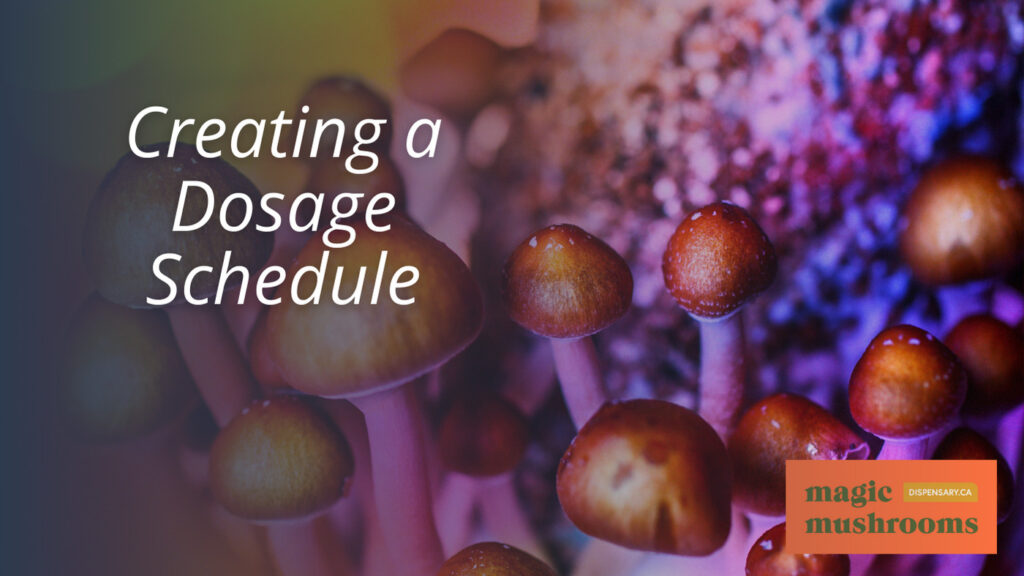
Establishing a precise dosage schedule is essential for individuals engaging in the practice of microdosing magic mushrooms, ensuring the experience remains both beneficial and manageable. A typical regimen involves consuming 0.1-0.5 grams of magic mushrooms every third day. This schedule is designed to prevent the buildup of tolerance, allowing the user to maintain the subtle, intended effects without venturing into the domain of a whole psychedelic experience.
Adhering to a consistent dosage schedule is crucial for reaping the potential benefits of microdosing. The effects are meant to be mild, enhancing daily activities without causing significant alterations in perception or cognitive function. Given the individual differences in sensitivity to psilocybin, some may find it necessary to adjust their dosage. This adjustment should aim to find a balance where the effects are perceptible yet not overwhelming, ensuring that the microdosing practice enhances rather than disrupts daily life.
To optimize the microdosing experience, it is recommended that a detailed journal be maintained. This journal should track the dosage, the effects experienced, and any changes in well-being or performance. Documenting this information can help individuals fine-tune their dosage schedule, adjusting based on personal sensitivity and the desired effects level. By following these guidelines, individuals can create a microdosing schedule that maximizes the potential benefits while minimizing any risks associated with the practice of microdosing magic mushrooms.
The Importance of Set and Setting
Understanding the significance of set and setting is vital when initiating the journey of microdosing magic mushrooms, as these factors play a critical role in shaping the experience’s outcomes. The concept of ‘set’ refers to the internal landscape of an individual, encompassing mindset, emotional state, and expectations from the microdosing experience. It is essential to approach microdosing with a positive and open attitude, as this can significantly influence the perception and impact of the experience. Preparation about mental readiness, managing expectations, and emotional stability is vital to ensuring a beneficial microdosing session.
On the other hand, ‘setting’ pertains to the external environment in which microdosing takes place. This includes the physical surroundings, social context, and the level of comfort and safety the individual feels. A supportive and serene environment can significantly enhance the experience, making it more conducive to the therapeutic benefits sought from microdosing magic mushrooms. Choosing a setting that is familiar, peaceful, and free from distractions or potential stressors is recommended.
The research underscores the importance of a harmonious set and setting in maximizing the positive effects of microdosing and minimizing any adverse reactions. A conducive set and setting promotes a more favorable experience and supports the individual’s well-being by reducing anxiety and fostering a sense of security and comfort. Practicing mindfulness, setting clear intentions, and ensuring a supportive setting are all essential steps in preparing for a microdosing regimen that is as beneficial and safe as possible.
Tools and Equipment Needed
Beginning the journey of microdosing magic mushrooms requires specific tools and equipment to guarantee accuracy and safety. The cornerstone of precise microdosing is a high-quality, precision digital scale. This scale must be capable of measuring milligrams to ensure the correct dosage. The importance of accuracy cannot be overstated, as slight deviations in amounts can lead to notably different outcomes in your microdosing experience.
In addition to a reliable scale, glass vials or small containers are indispensable for storing pre-measured doses. These containers offer a convenient way to organize your microdoses and protect them from environmental factors that could degrade their potency. It’s essential to select containers that are easy to seal and protect the contents from moisture and air, which can deteriorate the psilocybin content.
For those sensitive to the earthy taste of magic mushrooms, incorporating the microdose into a daily routine can be made more palatable by consuming it with a piece of fruit or preparing it as tea. This method not only masks the flavor but can also make microdosing a more pleasant ritual.
Finally, maintaining a detailed journal or tracking system is essential for observing the effects over time. This tool will allow you to make informed dosage adjustments based on your experiences and outcomes, facilitating a more tailored and effective microdosing regimen.
Each of these tools plays an essential role in implementing a safe, accurate, and beneficial microdosing practice, ensuring individuals can explore magic mushrooms’ potential benefits with minimal risks.
Safe Storage Practices
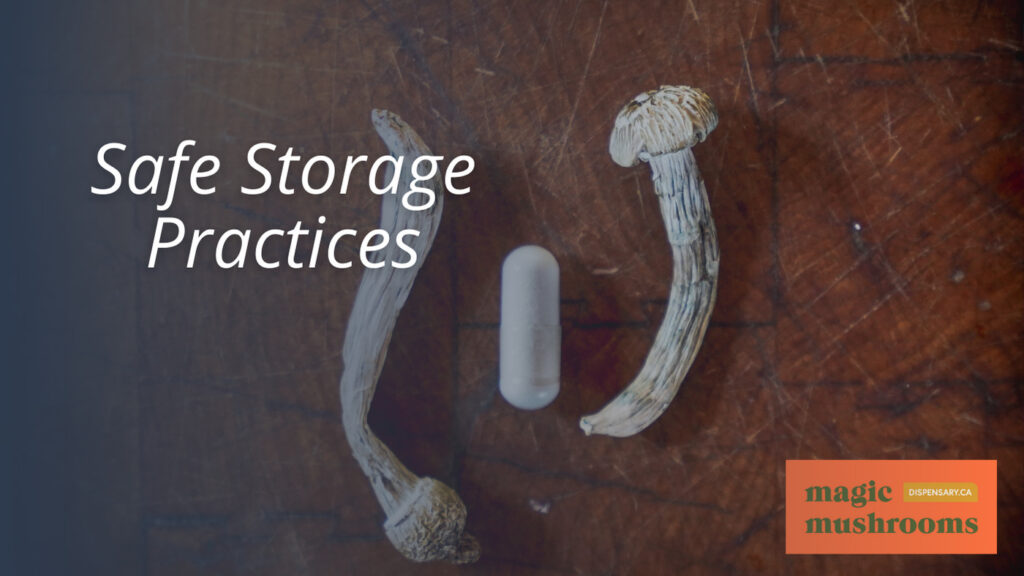
Implementing proper storage techniques for magic mushrooms is essential to preserving their quality and potency over time. Given the delicate nature of these fungi, understanding and adhering to ideal storage conditions can significantly extend their shelf life while maintaining their psychoactive properties. A few essential practices should be followed to ensure magic mushrooms are stored safely and effectively.
First and foremost, magic mushrooms must be kept in a cool, dark, and dry place. Exposure to heat, light, or moisture can lead to the degradation of psilocybin, the compound responsible for their psychoactive effects. This degradation not only diminishes the potency of the mushrooms but can also make them unsafe for consumption. Therefore, selecting an appropriate storage location away from heat sources, direct sunlight, and humidity is vital.
Next, it is recommended that the mushrooms be stored in airtight containers or vacuum-sealed bags to protect them from moisture and oxygen, both of which can further accelerate degradation. Containers should be sealed properly after each use to minimize exposure to air.
Moreover, labeling storage containers with the date of acquisition and the strain name is a good practice. This aids in quickly identifying different batches but also helps track their age, ensuring that older stocks are used first.
Lastly, it is essential to store magic mushrooms that are out of reach for children and pets. Their psychoactive nature poses a risk of accidental ingestion, which can lead to profound health implications. Making sure they are stored in a secure location mitigates this risk and upholds safety.
Tracking Your Experience
To effectively monitor the subtle yet significant impacts of microdosing magic mushrooms, maintaining a detailed journal of your experiences is essential. This practice facilitates a deeper understanding of the personal benefits and potential drawbacks and helps identify the best dosage for achieving desired outcomes. By systematically recording each dose, including the quantity of psilocybin consumed, users can track their progress and make informed adjustments to their regimen.
In addition to dosage, it is **essential** to note any observable changes in mood, focus, creativity, and overall well-being. Employing a rating scale for these aspects allows for a more quantifiable analysis of the effects, making it easier to discern patterns or trends over time. This quantitative approach, paired with qualitative notes on personal reflections and experiences, offers a **thorough** view of how microdosing influences daily activities and mental health.
Recording adverse effects or challenges encountered during the microdosing journey is equally **important**. This information provides valuable insights into the limits and potential risks associated with microdosing magic mushrooms, contributing to a safer and more effective practice.
Regular review and analysis of journal entries **guarantee** users can assess the cumulative impact of microdosing on their lives. By reflecting on documented experiences, individuals can make informed decisions about continuing, adjusting, or ceasing their microdosing regimen. This self-reflective process **ensures** that the practice remains aligned with personal growth goals and mental health considerations, fostering a responsible approach to microdosing magic mushrooms.
Managing Expectations
After exploring the importance of tracking your microdosing experience, it’s equally important to focus on managing your expectations regarding the outcomes of this practice. Microdosing magic mushrooms has garnered attention for its potential to enhance mental well-being and cognitive function. However, it’s essential to approach this practice with a grounded perspective. Expectations should align with the understanding that the effects of microdosing are subtle and can vary widely among individuals. This acknowledgment is critical in setting a realistic framework for what one might achieve through microdosing.
The research underscores the importance of maintaining a positive mindset and setting clear, achievable goals as part of the microdosing journey. This approach can significantly impact one’s experience, making it more beneficial and fulfilling. However, it’s also important to recognize that microdosing is not a panacea. The effects take time and may require time and patience to become apparent.
Adopting a patient, observant, and open attitude toward the process is advised. This mindset allows individuals to navigate better and understand the nuanced effects of microdosing on their mental health and daily functioning. Additionally, managing expectations helps in mitigating disappointment and fosters a more meaningful exploration of microdosing’s potential benefits.
Recognizing Subtle Effects
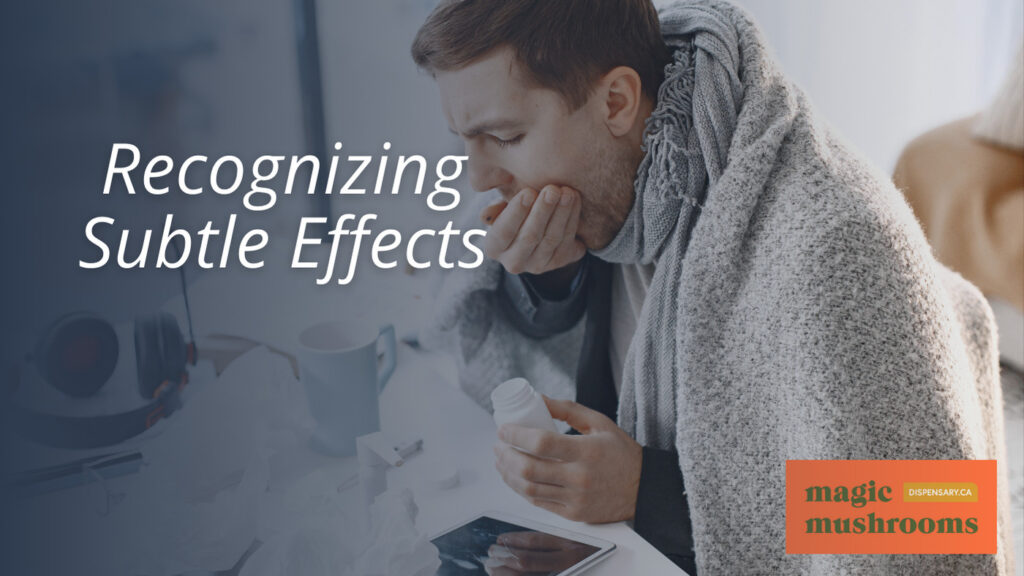
Recognizing the subtle effects of microdosing magic mushrooms necessitates a keen observation of one’s mental and emotional shifts, particularly in areas such as mood enhancement, creativity, and focus. Unlike the pronounced hallucinogenic experiences associated with higher doses, microdosing aims to provide benefits that integrate seamlessly into daily life without inducing intense visual or sensory alterations. Users often report a gentle uplift in mood, making the day’s challenges appear more manageable and less stressful. This mood stabilization can lead to a more positive outlook and an increased willingness to engage in social activities and tackle tasks with a renewed sense of purpose.
Enhanced creativity is another commonly cited effect, with individuals experiencing a flow of ideas and a heightened ability to think outside the box. This can be particularly beneficial in work environments that demand innovation or artistic pursuits where creative blocks are standard. Focus and cognitive function may also see improvement, with users noting better concentration and an ability to remain attentive to tasks for extended periods. This can translate into greater productivity and a heightened sense of accomplishment.
However, it is crucial to approach these benefits with skepticism and self-awareness, as the effects can vary significantly among individuals. The subtlety of the changes requires careful monitoring of one’s mental state and emotional well-being to attribute improvements to microdosing accurately. Recognizing these effects is subjective, emphasizing the importance of attentiveness to one’s own experiences.
Adjusting Dosages
Finding the ideal dosage for microdosing magic mushrooms requires careful calibration, starting from as low as 0.1g and potentially increasing to 0.5g of dried mushrooms, depending on individual factors such as body weight, metabolism, and sensitivity to psychedelics. Although seemingly narrow, this range encapsulates the nuanced approach necessary for identifying a dosage that aligns with the subtle yet impactful effects desired from microdosing.
For those new to microdosing, beginning at the lower end of the spectrum is advisable. Starting with 0.1g allows the individual to gauge their response to the psilocybin without overwhelming their system. Over time, and with attentive observation, the dosage can be incrementally increased. This systematic approach facilitates a personalized dosage that harmonizes with the individual’s unique physiological and psychological landscape.
Maintaining consistency in dosages must be considered. Consistent dosing provides a stable foundation from which the effects of microdosing can be accurately assessed and adjusted if necessary. Through this disciplined regimen, individuals can fine-tune their dosage to achieve the balance they seek between experiencing the benefits of microdosing and maintaining their daily responsibilities and activities without disruption.
Experimentation within the recommended dosage range is critical to finding the most suitable microdose. By incrementally adjusting the amount of psilocybin ingested and carefully observing the resultant effects, individuals can identify the dosage that best supports their mental health and well-being goals. This personalized approach ensures that microdosing magic mushrooms is both a safe and beneficial addition to one’s lifestyle.
Combining With Other Therapies
While adjusting dosages is a foundational aspect of microdosing magic mushrooms, incorporating other therapies into the regimen can significantly enhance the overall experience and potential benefits. Many individuals practicing microdosing find that combining these small doses with complementary therapies such as meditation, yoga, or mindfulness practices amplifies the benefits and fosters a deeper connection with oneself. This holistic approach can significantly improve mental health outcomes and assist in achieving a more balanced state of well-being.
You are engaging in therapy sessions or counseling while microdosing has been reported to produce a synergistic effect, making the therapeutic process more profound and impactful. This combination allows for enhanced emotional processing and can lead to personal growth and healing breakthroughs. Similarly, integrating microdosing with physical activities like hiking or nature walks leverages the subtle effects of psilocybin to heighten the connection with the natural world, enriching the therapeutic experience.
In addition, incorporating practices such as journaling or engaging in creative expression while microdosing can deepen self-reflection and foster emotional catharsis. These activities encourage a nuanced exploration of one’s thoughts and feelings, promoting mental clarity and insight. Additionally, utilizing music therapy or sound healing in conjunction with microdosing can create a detailed approach to mental well-being, offering a unique pathway to self-discovery and inner peace.
Navigating Challenges
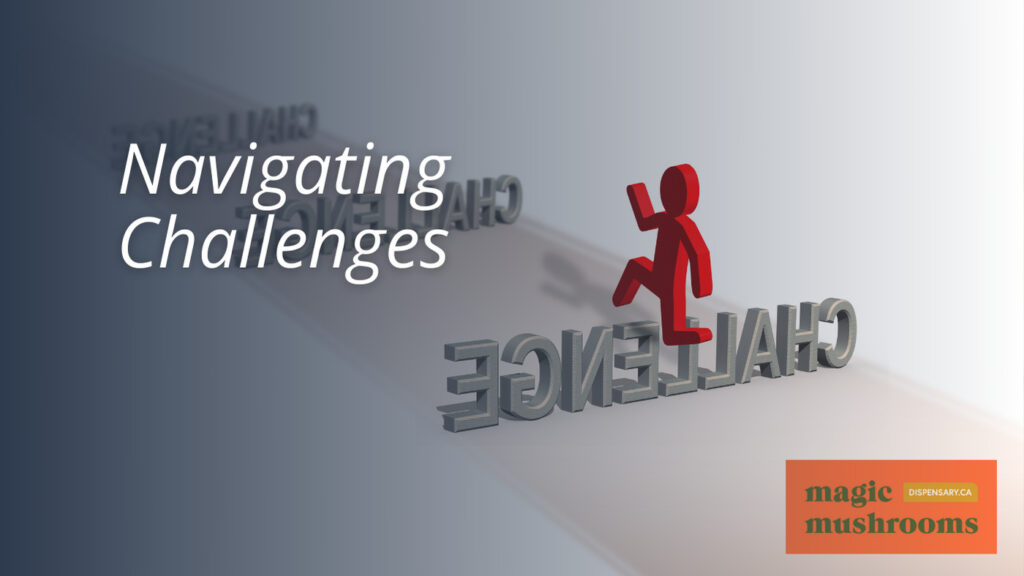
Exploring the complexities of microdosing magic mushrooms presents a unique set of challenges, from ensuring dosage accuracy to adhering to legal constraints. The practice involves consuming small, sub-perceptual amounts of psilocybin, the active compound found in magic mushrooms. However, achieving the correct dosage is complicated by the inconsistent potency of mushrooms, which can vary significantly based on species and drying methods. This variability makes it difficult to predict the strength of a dose accurately, posing the risk of consuming too much and experiencing unintended psychedelic effects.
Another critical challenge is the legal status of psilocybin. In many regions, it is classified as a controlled substance, which complicates access to quality mushrooms and can pose legal risks for users. Those interested in microdosing must navigate these legal barriers, often relying on underground or unregulated sources to obtain their supply. This raises legal concerns and questions of safety and quality, as products from such sources may need to meet health and safety standards.
Moreover, individual tolerance levels to psilocybin vary greatly, making it essential for users to start with a very low dose and adjust gradually. This cautious approach helps minimize adverse effects but requires patience and careful observation.
Accessing reliable information and resources can also be a challenge, as the practice is not widely accepted in the medical community due to the lack of conclusive scientific evidence supporting its benefits. As a result, individuals interested in microdosing must often rely on anecdotal evidence and personal experimentation, navigating the complexities of dosage, legality, and individual response on their own.
Signs of Overuse
Acknowledging the challenges associated with microdosing magic mushrooms, it is equally important to recognize the signs of overuse to maintain safety and well-being. Microdosing, while beneficial for some, carries the risk of overuse, marked by several physical, psychological, and behavioral indicators.
One of the primary signs of overuse is an increased tolerance to psilocybin, the active compound in magic mushrooms. Users may require progressively higher doses to achieve the same effects, indicating a concerning consumption pattern. Additionally, a persistent craving or preoccupation with obtaining and using magic mushrooms suggests a potential shift toward dependency.
Physical symptoms can also signal overuse. Individuals may experience nausea, headaches, or gastrointestinal issues as a result of excessive consumption. While not unique to mushroom overuse, these symptoms should not be ignored if they occur in the context of frequent use.
Psychological signs are particularly telling. Overuse may lead to paranoia, disorientation, or intense mood swings, which can significantly impact an individual’s mental health and daily functioning. Such symptoms reflect the potential psychological toll of excessive magic mushroom consumption.
Behaviorally, overuse may manifest as neglecting responsibilities, social withdrawal, or engaging in risky activities. These changes can profoundly impact personal relationships, employment, and overall quality of life.
Recognizing these signs is vital for individuals who microdose magic mushrooms. Early identification and intervention can help prevent the negative consequences associated with overuse, ensuring that microdosing remains a safe and beneficial practice.
Taking Breaks and Cycles
Implementing periods of rest between microdosing sessions, known as cycling, is essential to mitigate tolerance buildup and preserve the practice’s efficacy. Cycling is a structured approach to microdosing magic mushrooms, alternating between active dosing periods and breaks. This method is fundamental for maintaining the subtlety and effectiveness of the microdosing experience over time. Without these intentional breaks, individuals may find the effects of psilocybin diminishing, requiring larger doses to achieve the same outcomes, which defeats the purpose of microdosing.
The recommended breaks can vary, typically from a few days to a few weeks, depending on individual responses and tolerance levels. Notably, there is no one-size-fits-all approach to cycling; it requires personal experimentation and attentiveness to one’s own mental and physical responses. By closely monitoring these responses, individuals can tailor their microdosing schedules to optimize benefits while minimizing potential risks and side effects.
Cycling also prevents habituation, a process in which the individual becomes so accustomed to the drug’s presence that its effects are no longer noticeable. This is particularly relevant for microdosing practices that enhance well-being and cognitive function, as habituation can lead to increased doses and potential misuse.
Community and Support Networks
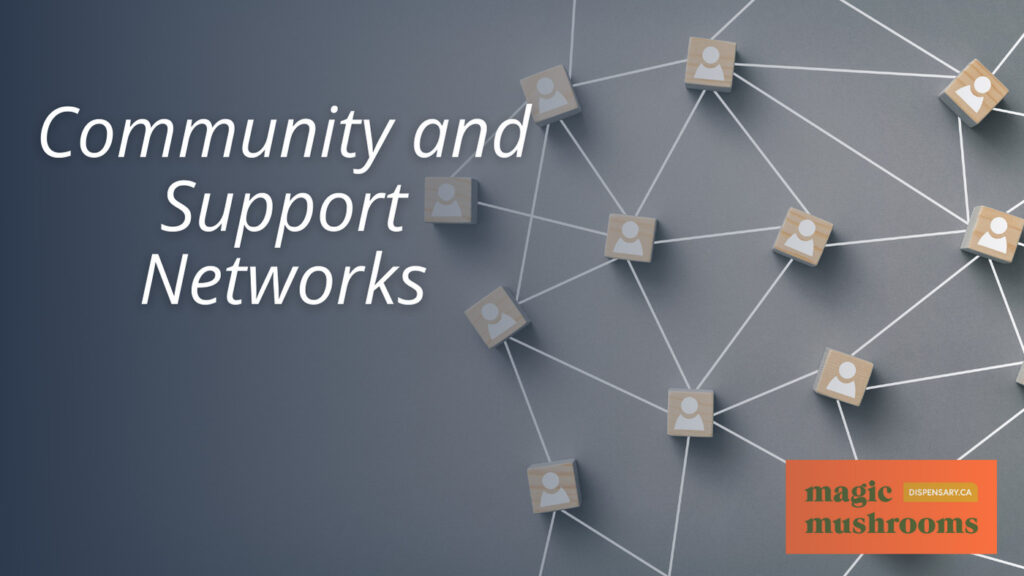
While cycling is a critical aspect in maintaining the efficacy of microdosing magic mushrooms, finding support through community and networks can significantly enhance the experience and provide valuable insights. Microdosing, involving sub-perceptual amounts of psilocybin, has cultivated a vibrant community of enthusiasts and practitioners who share their journeys, challenges, and successes. Online forums, such as Reddit’s microdosing community, have emerged as invaluable resources for newcomers and seasoned microdosers, offering a platform for exchanging experiences and tips.
Support networks like Microdose Pro extend beyond mere discussion, providing structured guidance and resources tailored to individuals looking to responsibly integrate microdosing into their routines. These platforms often serve as the first point of contact for many exploring the subtleties of microdosing magic mushrooms, offering a sense of direction and belonging.
Peer-led groups and organized meetups offer an added layer of engagement, facilitating face-to-face interactions and forming localized communities. These gatherings allow for deeper discussions, personal connection, and the sharing of firsthand experiences in a supportive environment. Similarly, social media platforms, including Instagram and Facebook, host groups dedicated to microdosing discussions, expanding the reach and accessibility of community support.
Additionally, a plethora of online blogs, podcasts, and webinars continue to enrich the microdosing community’s knowledge base, providing educational content that keeps individuals informed and connected. These resources play a critical role in demystifying the practice of microdosing magic mushrooms, highlighting their potential benefits while fostering a supportive network of like-minded individuals.
Addressing Common Concerns
Beginning on a microdosing journey with magic mushrooms prompts several key concerns, including safety, legality, and dosage precision, which demand thorough consideration. Safety is paramount; consulting a healthcare provider before initiating microdosing is advisable to ensure it aligns with one’s health conditions and won’t interfere with any current medications or treatments. This step is critical as it helps mitigate potential health risks and guarantees that microdosing is suitable for the individual.
Legality is another essential concern. The legal status of magic mushrooms varies widely from one jurisdiction to another. In many areas, psilocybin, the active compound in magic mushrooms, is classified as a controlled substance, making possession, sale, or use illegal. Understanding the legal implications in one’s region is essential to avoid unintentional legal violations. Individuals should thoroughly research local laws and regulations surrounding psilocybin to make informed decisions about microdosing.
Dosage precision is crucial for a successful microdosing experience. The typical range for microdosing magic mushrooms is between 0.1g to 0.5g of dried mushrooms, intending to achieve subtle, non-intoxicating effects that can enhance daily functioning without impairing cognitive abilities. However, the potency of psilocybin can vary significantly among different types of mushrooms, making accurate dosing challenging. Implementing quality control measures, such as using a digital scale for precise measurements and starting with the lowest possible dose before gradually adjusting, is essential for ensuring safety and effectiveness.
Beyond Microdosing: Other Uses
Exploring the domain of magic mushrooms extends beyond microdosing, as these substances are also utilized in higher doses for their therapeutic effects and spiritual practices for deeper introspection. Beyond the world of microdosing, which involves consuming small, sub-perceptual amounts of psilocybin, these fungi have garnered attention for their potential in treating mental health conditions like depression and anxiety. Research into the therapeutic applications of magic mushrooms is ongoing, with preliminary findings suggesting that, when used in controlled, higher doses, they can offer significant relief from the symptoms of these conditions.
In addition to their therapeutic uses, magic mushrooms play a significant role in various spiritual practices and ceremonies. Individuals seeking a deeper understanding of themselves and the universe may turn to these substances for their ability to induce profound experiences of introspection and self-discovery. This aspect is precious for those on a spiritual journey, offering a unique perspective on personal growth and existential questions.
Moreover, the potential of magic mushrooms to enhance creativity and problem-solving abilities has caught the interest of many in artistic and professional fields. By facilitating a shift in perspective, these substances can lead to breakthroughs in projects and ideas that require innovative thinking.
Psychedelic retreats and guided experiences represent another avenue through which individuals explore the benefits of magic mushrooms beyond microdosing. These structured environments provide a safe and supportive setting for participants to undergo transformative experiences, offering profound personal growth and insights into one’s psyche and consciousness.
Moving Forward With Mindfulness

Mindfulness practices offer a powerful tool to enhance the nuances of microdosing magic mushrooms. They ground users in the present moment and amplify their awareness of the experience’s subtle effects. By integrating mindfulness techniques, individuals can more effectively tune into the mild, often elusive benefits of psilocybin, such as enhanced creativity, emotional balance, and cognitive flexibility. The practice encourages a deeper self-awareness and intentionality, which can significantly enrich the microdosing journey.
Cultivating mindfulness goes beyond mere observation; it involves an active engagement with one’s mental and emotional landscape. This heightened awareness can help microdoses navigate any challenges or discomforts that might arise, providing tools to manage them with grace and insight. Additionally, mindfulness practices can foster a stronger, more intentional connection with the therapeutic potentials of magic mushrooms. By approaching microdosing with mindfulness, users are more likely to experience a harmonious balance between the psychedelic substance and their inner world, opening up profound personal growth and well-being.
Incorporating mindfulness into the microdosing routine can transform it from a passive to an active process of self-discovery and healing. Whether through meditation, breathwork, or simply cultivating moment-to-moment awareness, mindful approaches can significantly deepen the relationship between the individual and the psychedelic experience. As we move forward with mindfulness, the journey of microdosing magic mushrooms becomes not just a pursuit of mental health benefits, but a holistic exploration of consciousness, encouraging a life lived with intention, depth, and clarity.
Frequently Asked Questions
How Does Microdosing Magic Mushrooms Compare With Traditional Meditation or Mindfulness Practices in Enhancing Cognitive Functions and Emotional Well-Being?
The inquiry probes the comparative efficacy of microdosing magic mushrooms versus engaging in traditional meditation or mindfulness practices for improving cognitive functions and emotional well-being. While both approaches are sought for their potential to enhance mental health, the scientific community continues to explore their respective impacts. Evidence-based research is essential to conclusively determine their effectiveness, considering the legal and health implications of psilocybin use compared to the broadly accepted practices of meditation and mindfulness.
Can Microdosing Magic Mushrooms Induce Long-Term Neurological Changes, and Are These Changes Typically Beneficial or Harmful?
The current inquiry examines whether microdosing magic mushrooms can lead to long-term neurological changes, examining if these modifications are primarily beneficial or detrimental. Considering a hypothetical example of an individual consistently microdosing over a year, researchers would analyze cognitive and emotional health markers before and after this period. While anecdotal evidence suggests potential benefits, rigorous scientific evaluations are essential to conclusively determine the nature and extent of any long-term neurological impacts resulting from microdosing practices.
What Are the Environmental Impacts of Cultivating Magic Mushrooms for Microdosing, and How Can Sustainable Practices Be Implemented in Their Production?
If not managed sustainably, cultivating magic mushrooms for microdosing purposes can have environmental impacts, including potential strain on natural resources and biodiversity disruption. To mitigate these effects, it is crucial to implement sustainable practices such as minimal use of water and pesticides, responsible sourcing of substrates, and adoption of renewable energy sources in the cultivation process. Additionally, ensuring that cultivation does not contribute to the depletion of wild mushroom populations is essential for maintaining ecological balance.
How Do Individual Genetic or Biochemical Differences Affect One’s Response to Microdosing Magic Mushrooms, and Can Personalized Dosing Be Effectively Implemented?
Exploring the nuanced interplay between individual genetic and biochemical makeup reveals a complex landscape in how one may respond to psilocybin. This complexity underscores the challenge of implementing personalized dosing regimens. As our understanding deepens, the potential for tailored microdosing strategies emerges, promising a more refined approach to harnessing psilocybin’s effects. However, achieving this necessitates sophisticated research to navigate the intricacies of human physiology and its interaction with psychoactive compounds.
What Role Can Microdosing Play in Creative Processes or Artistic Endeavors, and Are Any Documented Cases of Notable Works Attributed to This Practice?
Microdosing’s role in enhancing creativity and artistic endeavors has been a subject of interest within various communities. This practice involves consuming sub-hallucinogenic doses of psychedelics, purportedly to unleash creative potential and improve cognitive flexibility. While anecdotal evidence suggests some individuals experience heightened creativity, documented cases of notable works directly attributed to microdosing remain sparse. Rigorous scientific studies are required to establish a definitive link between microdosing and its effects on creative processes.
Conclusion
To sum up, microdosing magic mushrooms presents a fascinating intersection of ancient practices and modern scientific inquiry. While anecdotal evidence suggests significant benefits regarding cognitive enhancement and emotional well-being, rigorous scientific research remains nascent. A notable statistic reveals that up to 20% of individuals engaging in microdosing report improvements in mental health conditions, underscoring the potential of this practice. Nonetheless, the legal landscape poses considerable challenges, necessitating a careful and mindful approach to further exploration and understanding.
Buying Microdosing Mushrooms Online in Canada
Are you an avid microdoser or looking to venture into the art of microdosing? Working with a reliable, trustworthy shrooms dispensary is paramount in your journey of becoming a better version of yourself. Magic Mushroom Dispensary prides itself on its comprehensive collection of top-notch microdosing products, psilocybin books, excellent customer service, and fast, discreet shipping. Visit our online shop today and enjoy low prices and free shipping for orders above $99.
Originally posted on March 19, 2024 @ 5:04 pm

